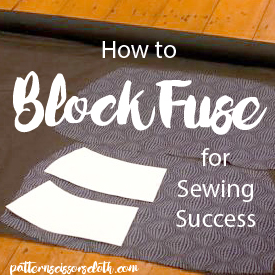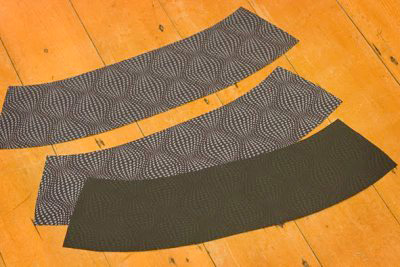Blockfusing is one sewing technique that you can’t afford not to learn! Compared to the traditional method it is quicker, more accurate, makes for easier handling, and gives more professional results. It is how we fuse things in the garment industry and is very simple – instead of cutting individual pieces and then fusing them together, you fuse them together then cut.
On this skirt I am making, I want to fuse the front yoke, the back yoke, and the front and back facings (which are actually the same pattern pieces as the front and back yoke.) I cut a block of fabric around the pattern pieces with a margin of about 1-2cm (1/2″) around the pattern. It doesn’t have to be precisely cut at this stage:

Next I lay the blocks of fabric on top of the fusing, wrong side of fabric to wrong/fusible side of fusing. Then I cut out a block of fusing the same shape as the cloth pieces, but about 5mm (1/4″) smaller – so it doesn’t extend over the edges and stick to your ironing board.
The pieces are fused together as they are placed – wrong sides together.
Now the pieces are ready to be cut exactly to the pattern piece. I like to mark around my pattern with tailors chalk, but you can pin and then cut if you are using a tissue pattern:
And the result – perfectly cut yokes and facings:
No wonky stretched or frayed areas, and seams that sew together easily – because they match! Try it – you’ll never look back as it will make your sewing easier!
Blockfusing can be used on any part of your garment where the full pattern piece is fused – collars, cuffs, plackets, waistbands, jacket fronts, pocket flaps, facings, etc.
A few comments on fusible interfacing:
I rarely use non-fusible interfacings, and have found that for 99% of my work I use two types of fusing. The one used here is a lightweight knit and I use it on most of my garments. It gives fabric just the right amount of body, and is extremely versatile – I have used it here on a flimsy georgette skirt, and I also use it in soft tailored jackets! For coats I use a slightly heavier weight.
An important factor to me in selecting a fusible is that it still maintains its drape once it is fused to your fabric – some turn stiff and card-like and I avoid those. Always test your fusing on the fabric you are applying it to – hold it up to your body as if you were wearing it and if you feel it is too stiff – find another one!
If you have any questions I am happy to answer them in the comments. Next up is a tutorial on hemming soft fabrics like chiffons and georgette, and how to mitre those corners!
Happy sewing 🙂





Great tip thank you. I am forever having trouble with my fussing sticking to the ironing board and being all wonky.
LikeLike
With blockfusing you will say goodbye to wonkiness forever!
I use a spare bit of calico over my ironing board when fusing to stop any mess, although by it's current appearance I must forget a lot of the time!
LikeLike
What a great idea! Why didn't I think of that?
Though I guess the only catch is that you need enough fabric because sometimes you lay out the pieces that need to be interfaced (fused) not necessarily next to each other. Also sometimes you need to fuse something that's on a fold…
How would you get it to work in that case?
LikeLike
Keren – If the pieces are not next to each other on your layout then cut a block around each individual piece before fusing. They don't necessarily have to be placed next to each other, it is just less work if you do!
LikeLike
Just so much easier! I'll be using that technique- thank you!
LikeLike
This will make my sewing life so easier. Thanks a lot for remembering me this method that I had forgotten
LikeLike
Thanks for showing the technique I'm going to try it, looks much easier this way..
LikeLike
I started doing this when I couldn't get the pieces to line up properly and always felt that I was doing something wrong, it's nice to know that I stumbled on to something professionals use.
LikeLike
Hi Sherry, Thanks for all the tips and tricks. I was always taught to only fuse the facings on the inside of a garment, not the outside part of the garment, but if I understand correctly you fuse both the outside part and the facings. Won't it get to bulky or stiff with two layers of fuse? English is not my mother language so I might have misunderstood. Hope to hear from you.
LikeLike
Funny tip! I only fuse the pattern piece itself, not the seam allowance…
LikeLike
This is a great technique. I lay everything over a layer of parchment paper on my ironing board. No sticky mess to deal with at all.
LikeLiked by 1 person